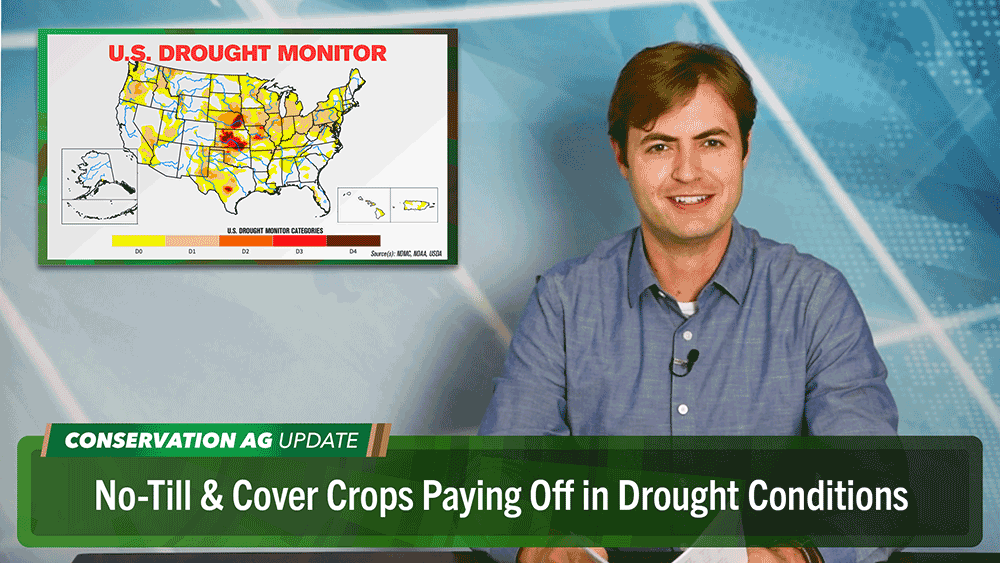In this episode of Conservation Ag Update, we explore how no-tillers are holding up in abnormally dry conditions throughout most of the U.S. Independent agronomist Jim Stute checks in from southeastern Wisconsin, and no-tiller Ryan Gibbs reports from eastern Iowa, where both areas have received minimal rainfall since April.
In the Cover Crop Connection segment, assistant editor Mackane Vogel shows how cover crops, if not managed properly, could affect soil moisture and take a toll on cash crops. Penn State Extension weed specialist John Wallace offers advice on how to manager cover crops in dry conditions.
Also in the episode, strip-till expert Tony Vyn reacts to the 2023 Strip-Till Benchmark Study results for the first time. Northwest Ohio, no-tiller and strip-tiller, Jeff Duling makes creative choices with his equipment, and a brewery in Iowa serves beer, brewed with corn from the late Dave Brandt’s farm.
This episode of Conservation Ag Update is brought to you by Saddle Butte Ag Bio Till Cover Crops.
Bio Till Cover Crops, a pioneer and leader in cover crop seeds, represents a complete lineup of seeds suitable for use in diverse soil types and growing conditions. Our focus on cover crop and regenerative forage seeds sets us apart from suppliers invested in other markets. Bio Till Cover Crops is dedicated to the expansion of the cover crop market by offering a superior, proven product matched with agronomic support from our outstanding team at a fair and competitive price point.
TRANSCRIPT
Jump to a section or scroll for the full episode...
- No-Till & Cover Crops Pay Off in Drought
- Cover Crop Connection: Managing Covers in Dry Climates
- Instant Reaction: 2023 Strip-Till Benchmark Study Results
- Farmer Feature: Jeff Duling Gets Creative with Cover Crops
- Photo of the Week: Honest Work Beer
No-Till & Cover Crops Pay Off in Drought
The big story right now is the drought, with much of the U.S. experiencing abnormally dry conditions.
Taking a look at the drought monitor map. Doesn’t look good as of June 8th — Those maroon colors in parts of Kansas, Texas and Oklahoma represent exceptional drought conditions with the potential for long term impacts.

Meanwhile, most of the Corn Belt is abnormally dry, with some areas experiencing moderate drought. Independent research agronomist Jim Stute checks in from a no-till farm in southeastern Wisconsin, where the crop is holding up OK, despite getting less than an inch of rain in May.
“Moisture stress is really on the mind of farmers. Why I wanted to come to this location is we have this dead residue here. It’s doing a good job of preventing evaporation, so we’re holding whatever kind of moisture is in the ground now. If we get rain, hopefully it will help with the rotation. The crop looks good despite not having significant rain since planting. It’s just one of the additional benefits to the cover crop.”
Similar story in eastern Iowa at Ryan Gibbs’ farm, where they’ve gotten even less rain over the past month. He’s been no-tilling for about 5 years and tells our Michaela Paukner that his decision to start using cover crops is really paying off in these dry conditions.
“We’ve had roughly 2/10, maybe 3/10 of an inch of rain in the last 35 days. But the cover crop has really protected the soil. Look at that — we’re not even an inch deep, and we’re hitting moisture underneath this residue. And this is like beach sand — real sandy ground. That’s the power of no-till and cover crops, preserving our moisture.”
Managing Cover Crops in Dry Climates
Planting cover crops during a drought can be a challenge. If not managed properly, they could affect soil moisture and take a toll on your cash crop.

A farmer posted this picture in the Everything Cover Crops Facebook group saying “cover crops killed my corn crop because of extreme drought.” The post received over 100 comments from other growers trying to offer advice on how he could have managed the cover crop differently to avoid significant damage to his corn crop.
Penn State Extension Weed Specialist John Wallace offers some advice on how to manage cover crops when you’re not getting enough rain.
And if you’re looking for more advice on cover crops, join the Facebook group “Everything Cover Crops” or visit CoverCropStrategies.com.
We’ve put together a list of resources for you to help navigate the drought on No-TillFarmer.com, check it out.
Instant Reaction: 2023 Strip-Till Benchmark Study
Turning our attention to strip-till now. In my hands, hot off the printer, results from the 10th annual Strip-Till Benchmark Study. I thought it would be fun to share some of the numbers with Purdue University strip-till expert Tony Vyn live on Zoom, so we could get his instant, unscripted reaction. Here are some highlights from our conversation, check it out.
NOAH: Average strip-till yields — 207 for corn and 61 for soybeans. Both ahead of US and no-till averages. I bet you’re not surprised by that.
TONY: Not at all. Those numbers are right in line with where I think strip-tillers are on average. Even if you assume there’s no advantage in terms of earlier planting, my experience is that we’re gaining at least 5-10 bushels of corn with strip-till.
NOAH: Survey respondents strip-tilled an average of 933 acres of corn and 586 acres of soybeans, the highest soybean total in the 10-year history of the survey. So maybe more are catching on to the advantages of strip-tilling soybeans?
TONY: Yes, and I think that’s a good thing. It’s also come about with a retrenchment of narrow row soybean production in the Midwest. Now whether that’s a good idea or not is up for debate.
NOAH: 61% seeded cover crops in strip-tilled fields. That’s consistent with recent surveys, but 8 points higher than the first survey we did in 2015. What’s your take on that — more strip-tillers using cover crops?
TONY: I think it speaks to the fact that dedicated strip-till producers are soil health conscious more so than those who rely on conventional tillage.
Check out the full 30-minute conversation on Strip-TillFarmer.com
Farmer Feature: Jeff Duling, Ottawa, Ohio
This week’s farmer feature spotlights a 50-year tradition of conservation practices in the northwest corner of the Buckeye State.
Ottawa, Ohio, no-tiller and strip-tiller Jeff Duling follows in the footsteps of his dad, Bob, who started no-tilling and cover cropping in the 1970s.

Jeff likes to think outside the box — he uses this custom 17-row toolbar to seed cover crops in between strips while sidedressing his corn at the same time. And that’s not the only cover crop trick this 6th-generation farmer has up his sleeve.
“Every field is different. I don’t know what time frame we’re going to be putting it on. It could be raining too much. There are certain cover crops that don’t work certain times of the year. Like sunflowers, you don’t want to put that out in the fall. Radishes, not in the fall. That’s early summer. So, I buy them in pellets — like crimson clover, rape, sunflower, radish, rye in bags — and then the day, or the week before, I use our old feed grinder that we used to grind cattle feed for. Take the grinding unit out, and it’s just a big blender. So, you’ve got a blender, you’ve got scales, you’ve got an auger.”
Photo of the Week: Honest Work Beer
Let’s wrap things up with our photo of the week. It comes to us from No-Till Farmer’s 2023 Conservation Ag Operator Fellow and No-Till Innovator Loran Steinlage in northeastern Iowa.

Loran with an Honest Work premium lager and Upper Iowa Common dark cream ale, both brewed with corn from the late Dave Brandt’s farm in Carroll, Ohio.
 |
 |
This is part of Pulpit Rock Brewery’s Dreaming of Field Days program, featuring 7 different beers brewed with local crops. Another great way to honor the legend, Dave Brandt.
Have an interesting photo or video from your farm? Or a story you’d like us to feature on the broadcast? Send me an email at Nnewman@lesspub.com.
And that will wrap things up this edition of Conservation Ag Update. Until next time, for more stories visit no-tillfarmer.com, striptillfarmer.com and covercropstrategies.com. Thanks for stopping by. Have a great day!








